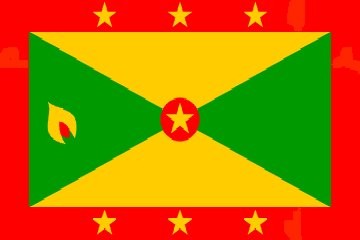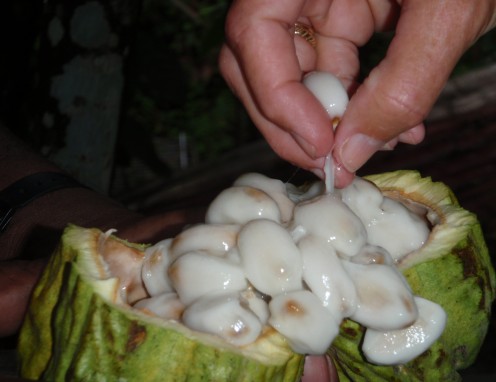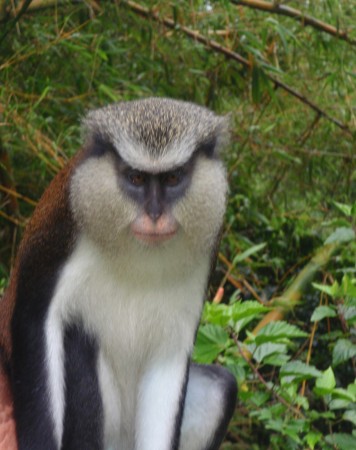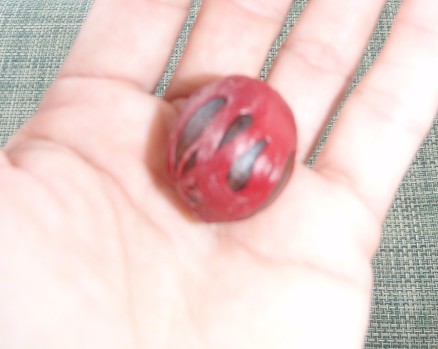GRENADA

We had a brief and fast sail across to Carriacou. We had good winds, and the seas were not bad. We anchored in Hillsborough – the only place where we could check in – and took care of business. We were checked in to Grenada.
Grenada was originally colonized as described on our Caribbean page. It was subsequently colonized by Europeans from 1498 until independence in 1974. However, after independence it experienced a revolution that induced invasion by US forces in 1983. It has been relatively stable since 1984.
Columbus sighted the island of Grenada in 1498 and claimed it for the Spanish crown. He named it Concepcion, and the Spanish ruled the island for 150 years.
Grenada became a French colony from 1649 till 1763. The French explorer, Jacques du Parquet, led an expedition which founded the first permanent French settlement on Grenada in 1649. The local population was in frequent conflict with the colonizers, and within five years there were few surviving locals. Most had fled to other islands or remote areas on Grenada. They had been effectively marginalized, and the few remaining groups of locals disappeared during the 1700s. Meanwhile, the French built the Grenadian economy on the backs of imported African slaves growing sugar cane and indigo.
Grenada was a British colony from 1763 until 1974. The British captured Grenada during the Seven Years’ War in 1762, and it was formally ceded to Britain by the Treaty of Paris in 1763. The island was briefly recaptured by the French in 1779, but it returned to British rule in 1783. A pro-French revolt occurred in 1795-1796, but the Brits retained control. Slaves on the island were freed in 1833, and nutmeg was introduced in 1843. Grenada became a Crown colony in 1877, and Grenada gradually evolved toward independence in the mid-20th century. It became independent in 1974.
Upon becoming independent, Grenada’s first Prime Minister was Sir Eric Gairy. However, there was conflict between Gairy’s government and the opposition party known as the New Jewel Movement (NJM). In 1979, a bloodless coup, led by Maurice Bishop of the NJM, overthrew the Gairy government. Further disputes arose between Bishop – a moderate – and other high-ranking members of the NJM who were more strongly pro-communist. In 1983, Bishop’s government was overthrown, and Bishop was placed under house arrest. Street demonstrations arose, and Bishop tried to regain power. He was executed; however, his body was never found. The island was placed under martial law and a military government was formed.
Then-US president Ronald Reagan was concerned that a moderate government (Bishop’s) was overthrown by pro-communist forces. He was further concerned about the presence of Cuban construction workers and military personnel on the island who were building a 10,000’ airstrip. The US feared that the airstrip would be used as a refueling stop for Cuban and Soviet airplanes despite assurances from American and European contractors that the airstrip lacked those capabilities. The US invaded.

A scenic hilltop in Grand Etang National Park
On October 25, 1983, the US military launched Operation Urgent Fury. This was supported by the Prime Minister of Dominica and later by the Governor General of Grenada, but it was criticized by the governments of Britain, Trinidad and Tobago, and Canada. The UN condemned it as “a flagrant violation of international law”. Nonetheless, eighteen arrests were made related to Bishop’s execution (seventeen convictions followed), and order was restored. US troops withdrew in December.
Since 1983, democratic elections have been reestablished. There have been occasional periods of social unrest, but there have been no further government coups.

Very heavy – Nita could not balance it on her head
Grenada is far enough south that it is out of the main hurricane belt. Grenada does get tropical storms, but hurricanes are rare. Until 2004, many believed that Grenada was safe from hurricanes. Ivan proved them wrong.
Prior to Ivan, Grenada had not had a hurricane since Hurricane Janet in 1955. Janet formed just east of Grenada only two days before she roared across the island with 115 mph winds (category 3) causing severe damage. She went on to become a record-setting category 5 hurricane.
Grenada did not experience another hurricane until Ivan in 2004 – 49 years after Janet. Ivan was a category 3 hurricane when he hit the island. This hurricane caused 39 deaths and caused severe damage including damaging or destroying 90% of the homes on the island.
Then Hurricane Emily hit less than one year later – in July of 2005. Emily was a category 1 hurricane with 92 mph winds. She hit further north than Ivan, but she caused serious damage.
Hurricanes have become a part of Grenada’s recent past. The locals speak of them as “the disaster”. They are likely to remain a part of Grenada’s future.
Grenada is at the southern end of the Windward Islands. It is northwest of Trinidad and Tobago, northeast of Venezuela, and southwest of Saint Vincent and Grenadines.
The country of Grenada includes the island of Grenada and eight smaller islands. The islands include Carriacou, Petit Martinique, Ronde, Caille, Diamond, Large, Saline, and Frigate Islands. The total land mass of the islands of Grenada is 133 square miles.
These islands are of volcanic origin, and they have extremely rich soil. The interior is mountainous, and Grenada’s highest point is Mount Saint Catherine at 2,756 feet. The main island of Grenada has many rivers and waterfalls.
Grenada’s population is approximately 110,000. This population is 82% black, 13% mixed black and European, and 5% other. Ninety five percent of Grenada’s population is at least partly black and descended from slaves. This is reflected in the local culture which has more African influence and less French influence than other Windward Islands.
Very few locals survived the purge during the French colonization. Consequently there are very few descendants from the original colonizers. There are, however, a few descendants of indentured workers imported from India.
The primary language is English, and much Grenadian Creole is also spoken. Ninety nine percent are Christian, and more than half are Catholic. The literacy rate is 98%.

Cocoa beans as they grow in their pod

A Mona monkey
Tourism is Grenada’s primary source of income. Most tourism is around the southwest corner of the main island, and a cruise ship pier has been built in St. George’s to accommodate large numbers of short-term visitors.
Grenada also has substantial income from agriculture – especially spices. Grenada is often called the “Island of Spice” because of its large production of spices – particularly nutmeg and mace. Grenada’s nutmeg production was reduced by 90% by hurricane Ivan in 2004; however, they are slowly recovering even if still not up to pre-hurricane levels. Grenada remains the world’s second largest producer of nutmeg after Indonesia. They also produce cinnamon, cloves, ginger, and allspice. They have recently become known for their organic cocoa production.
Government
Grenada has been an independent country since February 7, 1974. It is a parliamentary democracy under a constitutional monarchy. Queen Elizabeth II is the head of state. There are two legislative houses – the Senate and House of Representatives. The capital is at St. George’s.
After checking in, we explored a bit around Hillsborough – the only town on Carriacou. We had a very good lunch and bought a few things at a small grocery, but we did not see much else that appealed to us, so we returned to the boat. Back on the boat, we were not completely pleased with the anchorage, so we decided to move a few miles south to Tyrell Bay.
Tyrell Bay was surprisingly crowded with boats. But we found a good spot, and we had a quiet night there. We did not go ashore.
Grenada
Our friends, Greg and Debra, on Sonrisa had been working on boat projects in Prickly Bay on the south end of Grenada. We had hoped that they would sail north and meet up with us before they headed west, but their projects took longer than expected (they always do!), and they were feeling time pressured to head west. So we decided to sail south to Prickly Bay to see them before they left.
On April 4, we got up with the sun, and we had a mostly great sail south from Tyrell Bay on Carriacou to Prickly Bay on Grenada. Winds were in the mid-teens to low-twenties just forward of our beam, and Passage was flying. We were doing 8.4 knots as we approached the southwest tip of Grenada. But then we had to change course and go a few miles to the east. We lost the protection of the island, and our winds were 20 to 25 knots directly on the nose. But it was a small price to pay for the great sail we had the prior seven hours.

A very friendly Mona monkey mooching banana

Annendale Falls
We spotted Sonrisa as we entered the anchorage at Prickly Bay, and we anchored nearby. Greg and Debra spotted Passage when they returned from shore a little later. It was wonderful to catch up with long-time friends that we had not seen in a few years. We spent a lot of time together until they left for Bonaire almost a week later.
During that week, we went together to Grand Etang National Park. This is a 3,800 acre forest reserve named for the lake at its center – Grand Etang Lake. Grand Etang National Park is up in the hills at 1,740’ elevation. It is mostly rainforest surrounding Grand Etang Lake which is a crater lake – one of two on the island. The lake is the crater of an extinct volcano. Rainforest surrounds its shores, and there are trails through the forest. We hiked a trail through the rainforest and close to the shore of the lake. Although this is the ‘dry time’ on the island, the rainforest is always wet, and the trail was quite muddy. But it was a gentle, albeit muddy, two hour hike.
We took a tour on which we learned a lot about the crops of the island including cocoa, nutmeg, and other spices. We also learned about various fruits and vegetables grown on the island. We learned about and saw some of the devastation brought by Hurricane Ivan.
We returned to Grand Etang National Park with hopes of seeing the Mona Monkeys that live there (we did not see them when we went with Greg and Debra.) The Mona Monkey is common in western Africa, and they came to Grenada in the 18th century on slave ships. The monkeys were lured out of hiding with bananas and hard candies, and one of them jumped up on Bud to get a banana he was holding. They stayed around only as long as the free food lasted. They packed their cheek pouches with banana and candy, and they took their booty back in to the forest.
We visited Annandale Falls which is a small but beautiful waterfall in about the center of the island. It is only 30 feet high, but it is in a beautiful lush setting, and it falls in to a pool deep enough for swimming. A few young men there jump off the falls and ask for donations. We thought the falls would have been more enjoyable without the jumpers.
We went to River Antoine Rum Distillery. This distillery was founded in 1785, and it is the oldest functioning water-propelled distillery in the Caribbean. It was interesting to see rum still being produced by the same methods developed long ago, but the rum was terrible. It was unquestionably the worst tasting rum either of us has ever tasted. Dreadful stuff.
But we had boat work to do, so we had to curtail our tourism. We wanted to install new engine mounts and hoses on our primary engine, so we moved in to Port Louis Marina in St. George’s. Because the engine would not be operable while we were doing this work, we thought it would be safer to be in a marina.

Nutmeg and mace
We got a lot done while in the marina. We installed the engine mounts and hoses, replaced some engine room insulation, and rebuilt the toilet and replaced hoses. We did some overdue maintenance, and we had a survey done from the waterline up. The survey of the hull was deferred until we hauled out a few weeks later.
We left the marina and made our way toward Grenada Marine where we would haul out. We made two stops along the way. We returned to Prickly Bay for two nights, then we went around to Clarke’s Court Bay. We wanted to check out Clarke’s Court Bay as a possible place to hang out and do chores when we launch, but the bugs tried to eat Nita alive, so we took it off our list. Onward to Grenada Marine.
Passage was hauled out on May 15 without drama or trauma, but getting her ready for her long summer’s nap was a bit traumatic. Because Grenada is no longer considered to be out of the hurricane tracks (Ivan changed that in 2004) our insurance has very demanding requirements for boats left during hurricane season (May to November). She was in a one-piece steel cradle holding her up and webbing straps holding her down. We had to strip her like never before. Even her boom had to come off! And, of course, everything had to be stowed below. We should have allowed more than three days to accomplish this, but we underestimated the work it would require. But we made it, and we headed for the US via Trinidad.

Dave, Kathie (SV Sunflower) and Bud at Westerfall Distillery
We had return tickets for November 1, but we were almost three months late returning. Sometimes live intervenes in the best-laid plans. We got back to Grenada on January 22. It took us two weeks to complete the projects that we had to do prior to launch, and we got back in the water on February 4. We again headed to Port Louis Marina in St. George’s where we could finish other projects.
We ran into old friends, Kathie and Dave Blanding (SV Sunflower), while still at Grenada Marine, and they too moved over to Port Louis Marina. We met them in Tonga in 2005, but we have only occasionally seen each other. So we have had great fun spending time with them.
One of our outings was to the Westerhall Distillery. We went on a Saturday, and they were closed. But one of the local employees took pity on our long faces and gave us a private tour.It was far better than any organized tour would have been. We bought a bit more rum (their 15 year old Vintage is very good) and stopped for lunch on the trip back. Just another beautiful day on a beautiful island.
We also made a visit to Gouyave for Fish Friday. Five cruising boats hired a taxi van to drive us up there, wait a few hours, and drive us back.
Gouyave is a fishing village on the northwest coast of Grenada. Fish Friday began as an effort to promote community development, and it has become an island institution. Every Friday evening, vendors set up canvas canopies under which they cook huge amounts of fish. It is mostly fried, but a few items are grilled. They serve everything from flying fish to lobster.
There were approximately fifteen canopies set up the night we were there. All were selling fish except two – one very busy woman was selling beer and some local drummers were performing under another.
We have probably never before consumed so many fat calories at one time, and we hope we do not do so again. But most of it was good, so we gobbled it down. Calories be damned! It was a fun and tasty experience that we would recommend to others.
We completed our remaining projects, and we planned to leave Grenada early in the day on February 24. But we had to check out with customs and immigration. Then we checked out of the marina. We discovered and repaired a fresh water leak at the galley sink. Then we said ‘goodbye’ to friends old and new. It was 1:00 pm already. So we left the marina and went only as far as the anchorage just outside.
The anchorage looked calmer than when we had previously stayed there, so we decided to spend the night. The water leak resumed, and we spent four or five hours working on it. We got it fixed, but we will not have hot water at the galley sink until we replace some parts. The roll in the anchorage also resumed, and we spent another night rolling around in Grand Anse. (All the anchorages we have been in on Grenada have been rolly.) We headed off the next morning.
Return to St. Lucia, St. Vincent & the Grenadines, or our Caribbean page.
Or you can sail with us from Grenada to Bonaire
Or jump ahead to Bonaire